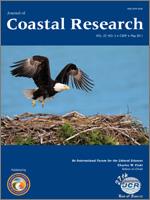Florida (United States) beaches serve as globally important nesting habitat for protected species of sea turtles. Following coastal development, portions of this habitat have become inaccessible to nesting sea turtles due to coastal armoring and other barriers. To assess nesting habitat quality, we randomly selected beaches totaling 80.45 km in each of four regions of Florida (northeast, southeast, northwest, and southwest) and surveyed them for potential barriers to nesting during the period of April 2001 to May 2002 (total surveyed coastline = 321.8 km). Potential barriers to nesting were found in 78 forms on sampled beaches, including seawalls, revetments, sand bags or tubes, sand fences, access structures, recreational equipment, and buildings. We determined the position and extent of structures using a differential global positioning system. Surveyed beaches made up 24.5% of Florida's sandy coastline and were sampled to be regionally representative. In an assessment summed for all regions, potential barriers to nesting occupied 18.0% of the total surveyed beach length. The region with the greatest extent of potential barriers was southeast (23.8%), followed by southwest (21.7%), northwest (14.1%), and northeast (12.3%). Seawalls were the most common potential barriers in all but the northwest region, where sand fences were most common. Our measurements did not include structures that were hidden from view by sand or other structures. Following coastal effects from four major hurricanes that made landfall in 2004, we resurveyed 16 km of beach in each region (total = 64 km). We recorded a net reduction of sand fencing in northeast and northwest Florida and a net reduction of revetment rocks in the southwest region due to covering by sand. However, the linear extent of barriers increased in northeast and southwest due to seawall construction and additional sand fencing.
How to translate text using browser tools
1 May 2011
Barriers to Sea Turtle Nesting on Florida (United States) Beaches: Linear Extent and Changes Following Storms
Blair Witherington,
Shigetomo Hirama,
Andrea Mosier
ACCESS THE FULL ARTICLE

Journal of Coastal Research
Vol. 27 • No. 3
May 2011
Vol. 27 • No. 3
May 2011
Caretta
Chelonia
Coastal armoring
Dermochelys
green turtle
leatherback
loggerhead




